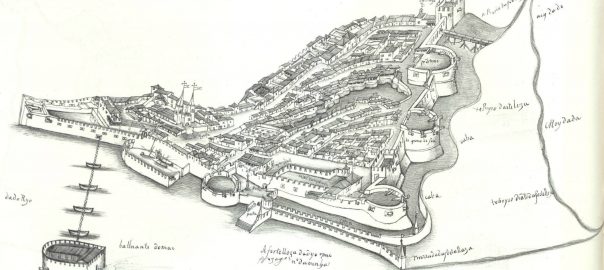1538 CE was a huge year for the Ottoman navy– in both the Mediterranean and the Indian Ocean. It also saw the usual kinds of things going on, on land, in Europe and the Americas, and some tragic things happening in China:
- Diu is a coastal city in Gujarat in northwest India. In the early 1530s, the Sultan of Gujarat, fearing the approach of the Mughals, did a deal with the Portuguese, whose naval expeditionaries had established a number of bases around the Indian coast, granting them Diu on condition they build a fort there and protect the Gujarat Sultanate. After the Mughal threat receded, the Sultan asked the Portuguese to leave, but they refused. (No surprise there!) The Sultan then asked his co-religionist Suleiman the Magnificent to send a relief force from the Ottoman/Egyptian base at Suez. Suleiman sent a very large force to do this which arrived in February 1538. There were some epic battles, betrayals, etc but by October the Ottomans had been repelled. English-WP tells us: “The defeat of the combined Turkish and Gujarati forces at Diu represented a critical setback in Ottoman plans for expanding their influence into the Indian Ocean… leaving the Portuguese uncontested in the western Indian coast. Never again would the Ottoman Turks ever send so large an armada to India. After the failed siege, the Ottomans returned to Aden, where they fortified the city with 100 pieces of artillery. Suleiman Pasha [that was the Egyptian underlord of Suleiman the Mag] also established Ottoman suzerainty over Shihr and Zabid, and reorganized the territories of Yemen and Aden as an Ottoman province, or Beylerbeylik.”
- In the Mediterranean, meanwhile, Ottoman sea power was performing better. In a late-September naval battle near Preveza in the northwest of today’s Greece, an Ottoman fleet defeated one assembled by Pope Paul III. English-WP describes this as one of the three largest sea battles that took place in the sixteenth century Mediterranean, along with the battles of Djerba and Lepanto– both yet to come.
- In Europe, Ottoman diplomacy made a small gain in Hungary. A truce was declared in Nice between the Spanish and French monarchs in the “battle for Italy” they’d been pursuing since 1536. That “battle for Italy” had been the reason France’s King Francis I had reached out for Ottoman diplomatic ties/support. In England, Henry VIII continued dissolving/looting monasteries.
- In the Americas: In Peru, Pizarro had a victory over the Incas and regained Cusco; and elsewhere in the continent conquistadores continued conquistadoring.
- In Ming Dynasty China, the first in a decade-long series of severe famines and epidemics swept the center and southeast of the country. A tsunami flooded over the seawall in Haiyan County of Zhejiang province, inundating fields with saltwater and ruining many acres of crops.
By the way, the Ottoman and Portuguese forces would continue to tussle in and near the Indian Ocean until 1559. Those naval (and sometimes terrestrial) battles would determine a lot about the balance of power in the Indian Ocean. The Ottomans were accessing the area by land over Egypt and to a lesser extent over Iraq. The Portuguese had to sail all around the Cape of Good Hope, so their ability to maintain and provision their forces in the area, such a long sailing distance from Lisbon, depended a lot on them being able to maintain strong and profitable trading relations with local coastal rulers.
The image above is a near-contemporary drawing of the fortress of Diu, by Gaspar Correia.
